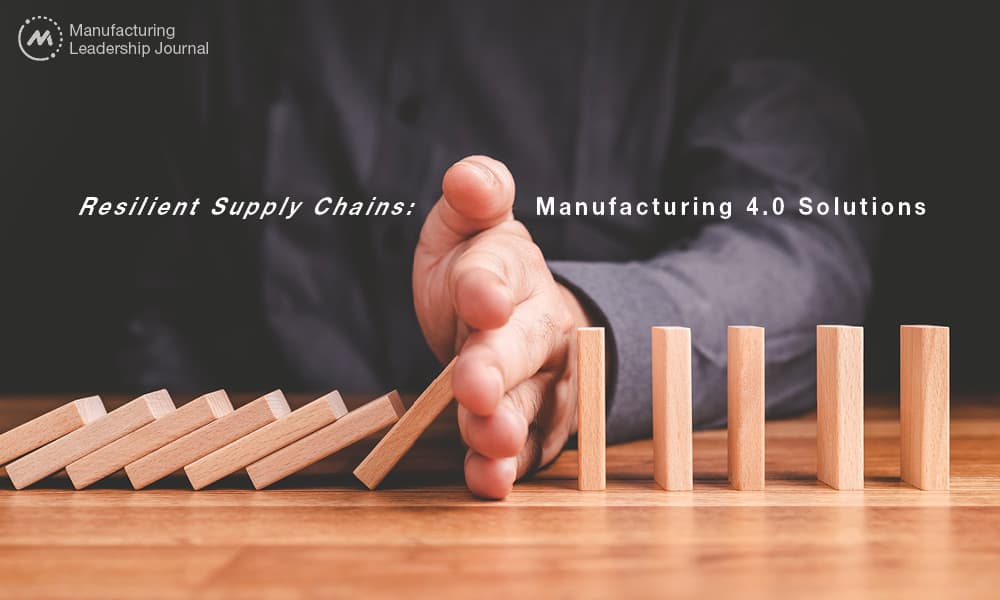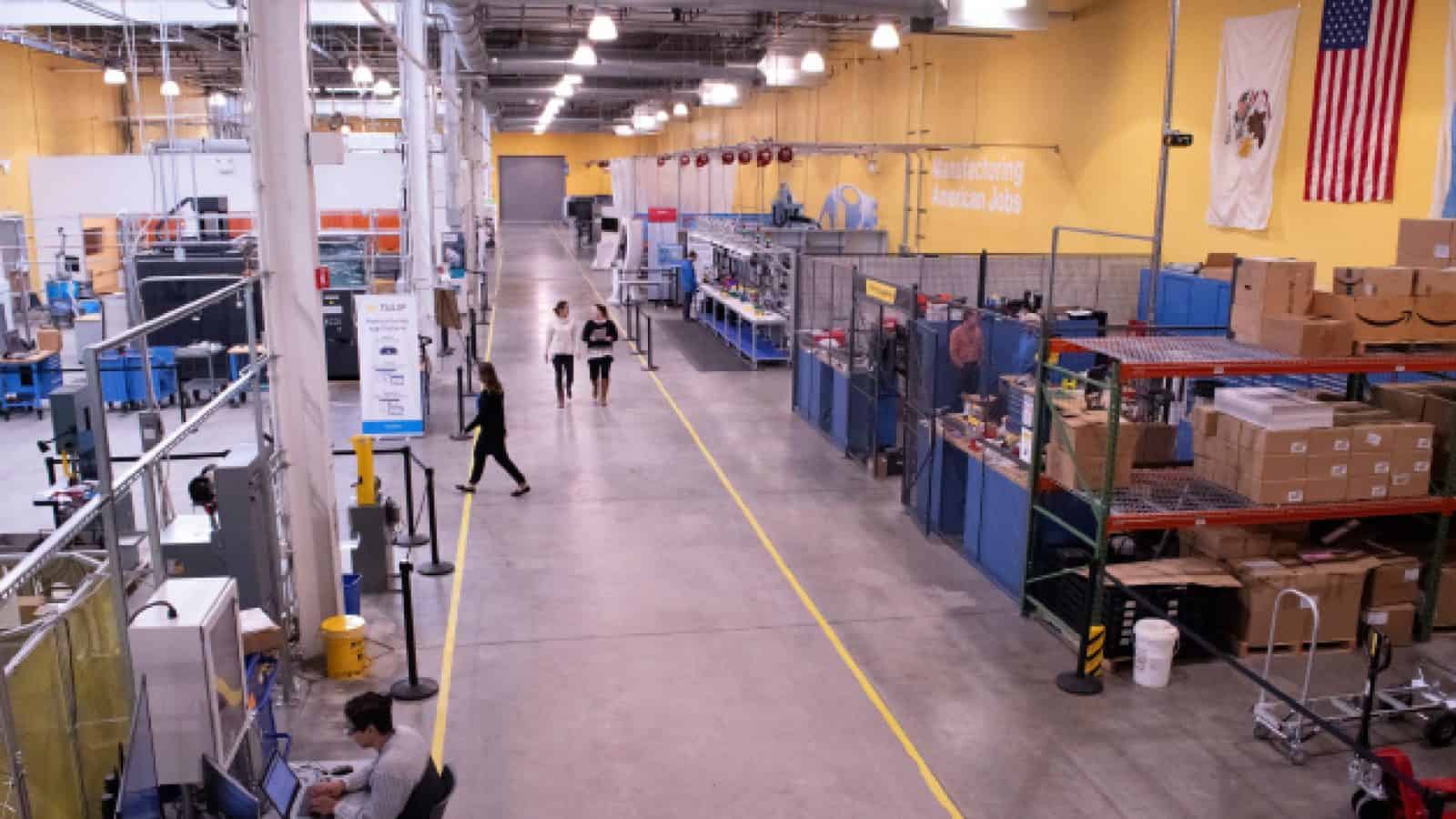Resilient Supply Chains: Manufacturing 4.0 Solutions

How resilient supply networks enable supply chain leaders to predict, manage, and respond to constant disruption.

TAKEAWAYS:
● Resilient supply networks and collaborative ecosystems, supported by Manufacturing 4.0 technologies, enable supply chain leaders to predict and resolve disruption effectively.
● Companies are using Manufacturing 4.0 technologies to improve visibility, planning, and information management; creating platforms to identify key events and coordinate effective responses, as exemplified by Unilever’s use of predictive AI during the COVID-19 pandemic.
● Building resilient supply chains involves proactive risk identification, communicating and collaborating with suppliers and partners, and pursuing leading supply chain best practices.
In recent years, supply chain disruption has been the main catalyst for evolution in the manufacturing industry. And with supply chain disruption, we have seen a shift towards resilience rather than the typical focus on cost and service. What was previously thought of as “once in a lifetime” crises have become the norm as the frequency and costs of each disruptive event have increased.
To succeed in this environment, resilient supply networks and collaborative ecosystems are needed to communicate and plan across suppliers, partners, and customers. These networks are increasingly supported by Manufacturing 4.0 technologies, including digital solutions to improve visibility, planning, predictability, and the rapid response to disruption, all working in tandem to enable greater resiliency across the supply chain.
Resiliency starts with proactive risk identification and assessment, identifying sources of risk and associated probabilities. While adaptability to unforeseen challenges is often seen as the hallmark of resilience, predicting and preparing for issues before they present themselves ensures the best outcomes. With this, companies are looking to digitally support business planning, risk management, and organizational preparedness for future disruptions.
The evolution of supply chain thinking
As disruptions increasingly serve as a catalyst for change, the way leaders manage and think about supply chains is changing, too. The COVID-19 pandemic served as a watershed moment, reshaping entire industries as supplies of protective equipment and health and hygiene products were stretched beyond historic constraints. Other products experienced dramatic peaks and valleys in their demand curves – causing manufacturing and supply shortages – followed by increased inventories, and eventually a need to scale back production dramatically.

“Resiliency starts with proactive risk identification and assessment, identifying sources of risk and associated probabilities.”
But the pandemic is far from the only disruption in recent history. Climate change is wreaking havoc as natural disasters and dangerous weather conditions are now a constant concern across the world. Just recently, wildfires burning across Canada led to unsafe air quality spreading as far as the southern United States. Global political unrest, economic instability, and cybersecurity concerns have further led to an environment marked by insecurity and vulnerability.
By embracing Manufacturing 4.0 technology for improved visibility into the current state of operations, as well as predicting how different actions will impact outcomes, leaders can better support scenario planning, risk management, and overall organizational preparedness.
Technology to predict and manage supply chain disruption
Unilever is a great example of a brand using Manufacturing 4.0 technology to predict and manage the effects of external threats. During the pandemic, we worked with Unilever to support their people while securing their supply chain to continue delivering products to their 2.5 billion customers worldwide. Together, we rolled out a predictive artificial intelligence tool: COVID-19 Awareness and Situational Intelligence (CASI) technology.
The CASI tool monitored and predicted global COVID-19 trends, providing a regional analysis relating to individual Unilever sites worldwide. With up to 80 percent accuracy, the dashboard enabled leaders to predict workforce trends and take action to keep employees safe during high-risk times while ensuring that its locations across the world were well-equipped to keep up with supply chain demands.
Diversification to weather times of uncertainty
Other ways to boost resilience include diversification of and collaboration with suppliers and partners. When companies rely on one key supplier, their entire supply chain can become derailed if that supplier encounters trouble, the infamous “single point of failure.” Trade tariffs, material issues, and worker shortages are all valid concerns. Widening the net and finding trade partners in a variety of regions can ensure that if one supplier is unable to deliver, fall-back options are available to keep lines moving. Furthermore, digital tools are providing companies with greater visibility deeper within their supply chains to see where critical supply, geographic market, and operations constraints may exist. This higher level of visibility improves mitigation planning, and with it, greater agility, and resiliency.
A supplier ecosystem that reflects consumers
Diversity in the supply chain goes beyond product offerings and individual companies – it all comes down to people. As brands commit to responsible supply chains that work towards the betterment of the world, those that prioritize people tend to come out on top. Procter & Gamble (P&G) is just one example of a major brand that focuses on the diversity of suppliers to create a supply chain that is representative of its consumer base. This includes working with businesses that are owned by ethnic minorities, women, members of the LGBTQ+ community, people with disabilities, and U.S. veterans.

“Digital tools are providing companies with greater visibility deeper within their supply chains to see where critical supply, geographic market, and operations constraints may exist.”
P&G also makes it a point to source materials and products responsibly, considering factors such as human rights and environmental risk across its supply chain. By monitoring and minimizing harm wherever possible, the brand safeguards the future for those living in areas where the company does business, as well as the planet at large.
While many companies today are working towards environmental, social, and governance (ESG) goals, P&G is one example of a company that not only pursues these goals on its own but empowers suppliers that are making strides to improve as well.
Overcoming obstacles to build resilient supply chains
While many leaders understand the importance of resilience, overhauling processes and getting the entire organization on board can be difficult. Resistance to change, ignorance of the risks of continuing business as usual, budget limitations, and other concerns are common issues limiting progress.
To overcome these challenges, it is vital to instil a culture of resilience and show organizational commitment from the start. This includes getting buy-in from other leaders across the firm and establishing cross-functional teams to assess what needs to change, who needs to be involved, what the process looks like, and the desired outcomes. It also requires leaders to maintain a strategic focus on building resiliency for the long term, while they may be addressing current issues in the short term. Many companies have ignored addressing their supply chain challenges because they are focused on immediate relief of areas such as order backlog, but this does not address the root causes of the backlog in the first place.

“To overcome challenges, it is vital to instil a culture of resilience and show organizational commitment from the start.”
Collaboration is key. Working with other partners across the supply chain ecosystem opens the door to new ideas and implementation strategies. They may even have access to data analytics that can be used for risk assessment and decision-making. The better partners can monitor, prepare for, and manage crises, the more secure the overall supply chain will be for all players.
Similarly, leaders can discuss key learnings from previous disruptions and share strategies that have helped in the past. These proven strategies, combined with the latest digital solutions, can reduce the impact of disruption, and strengthen the overall supply chain moving forward.
Recognizing the next supply chain disruption
As organizations focus on resiliency, it is important to understand the challenges they will need to prepare for in the coming decades. While the past few years have offered a glimpse into the unpredictability of business and life in general, already, we are seeing trends that will require further attention:
- Emerging technologies, including AI: As technology and processes become more advanced, they also become more vulnerable. Increased automation associated with Manufacturing 4.0 has greatly improved productivity and worker safety, but hacking is a real threat that continues to grow. Digitalization is the future, but a greater emphasis and investment in cybersecurity and awareness is needed to keep information, equipment, and especially people, safe.
- Climate change: As mentioned, destructive weather events are becoming more frequent and severe because of climate change. Atmospheric conditions are shifting, ocean salinity is changing, and seasonal patterns are being altered at unprecedented rates. These factors have immeasurable impacts on supply chains as crops are lost to flooding, drought, and wildfires, and as critical infrastructure is left vulnerable to damage from these events. Manufacturers such as Schneider Electric are providing AI-enabled products to predict where damage is most likely to occur and pre-emptively harden systems and/or get teams in place to correct any issues.
- Geopolitical uncertainties and trade challenges: We have already seen how the war in Ukraine led to grain shortages worldwide, and that is just one prominent example of how war and politics affect product supply and prices across the globe. Additionally, trade regulations and tariffs are always changing, resulting in further disruption. Diversifying the supply base allows companies to continue sourcing necessary products from a range of providers if one or more get cut off due to regional circumstances.
- Evolving customer demands and expectations: Next-day shipping and same-day delivery have changed the game on consumer expectations. But these are not the only shifts in the customer landscape, as buyers also expect brands to commit to ESG targets, improve transparency, simplify ingredients, and more. Committing to do better for the planet lets customers know that their values are aligned with the business.
Boosting resilience with Manufacturing 4.0
Lessons from the past few years show that disruption, and its impacts, are not going away. As leaders manage this new reality, a drive towards collaborative resilient supply networks has proven to be an effective strategy to predict, manage, and respond to these disruptions.
While there are many avenues to resilience, investing in modern technology remains one of the most valuable ways to build the capabilities that provide visibility, planning, predictability, and rapid response. AI has enabled leaders to track the spread of disease, monitor and predict damage from weather events, assess customer expectations, and more. There are risks to all new products, and cybersecurity remains a concern, but the benefits of greater visibility and informed planning for the future cannot be overstated.
We have seen how quickly supply landscapes change in the face of a crisis. Using Manufacturing 4.0 technologies, leaders can plan for disruption while optimizing supply chains in the meantime. Striking the balance between new technologies and tried-and-true strategies like collaboration and diversification will be key to resilience in the coming years. M
About the authors:

Shanton Wilcox is a Partner and America’s Leader in Manufacturing at PA Consulting

Andy Prinz is a manufacturing and supply chain transformation expert at PA Consulting
